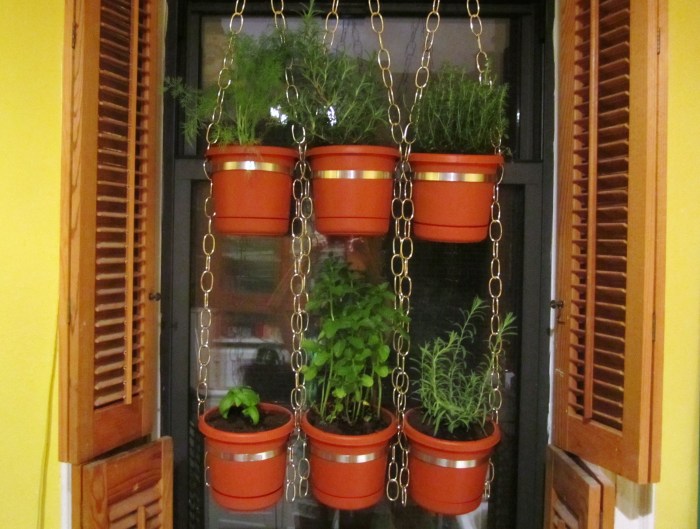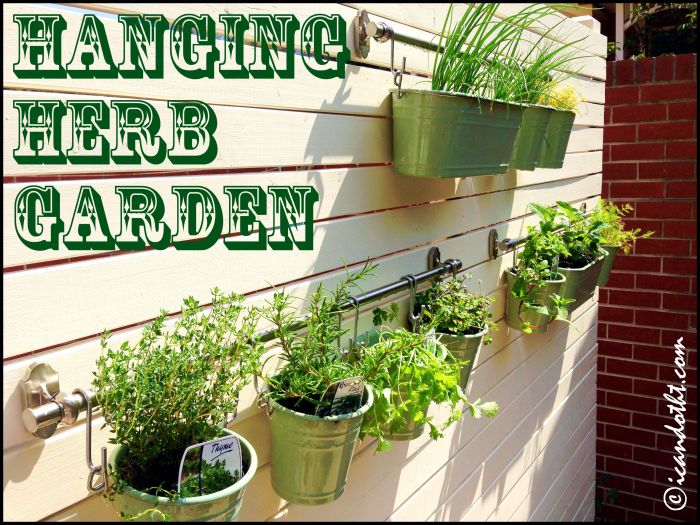Hanging window herb gardens offer a delightful fusion of aesthetics and practicality, transforming your windowsill into a thriving vertical oasis. Not only do they add a touch of freshness to your home décor, but they also provide you with an abundance of flavorful herbs right at your fingertips.
With a wide range of herbs to choose from, you can create a customized garden that caters to your culinary preferences. From the aromatic basil to the zesty oregano, each herb brings its unique charm and versatility to your dishes.
Whether you’re a seasoned cook or a culinary novice, a hanging window herb garden empowers you to elevate your cooking with the vibrant flavors of fresh herbs.
Herb Selection and Care

Hanging window herb gardens offer a convenient and space-efficient way to grow fresh herbs indoors. Selecting the right herbs and providing proper care are crucial for a thriving and productive garden.
When choosing herbs for hanging window gardens, consider sunlight requirements, water needs, and companion planting. Herbs that thrive in partial shade, such as parsley, mint, and chives, are well-suited for north-facing windows. For south-facing windows with ample sunlight, consider rosemary, thyme, and basil.
Watering
Hanging herb plants require regular watering, especially during hot and dry weather. Check the soil moisture regularly and water when the top inch of soil feels dry to the touch. Avoid overwatering, as this can lead to root rot.
Growing herbs in a hanging window herb garden is a convenient and space-saving way to bring the freshness of nature indoors. If you’re looking for a more permanent solution, consider using wall pots indoor to create a vertical herb garden that adds a touch of greenery to your walls.
Wall pots come in various sizes and materials, allowing you to customize your herb garden to suit your space and decor. By incorporating wall pots into your hanging window herb garden, you can enjoy the benefits of fresh herbs year-round, adding flavor and vitality to your culinary creations.
Fertilizing
Fertilize hanging herb plants every 2-3 weeks during the growing season with a balanced liquid fertilizer. Follow the manufacturer’s instructions for dilution and application.
Pest Control
Common pests that can affect hanging herb plants include aphids, spider mites, and whiteflies. Inspect plants regularly and treat infestations promptly with insecticidal soap or neem oil.
Pruning and Harvesting
Regular pruning promotes healthy growth and maximizes yield. Pinch back the tips of stems to encourage bushier plants. Harvest herbs by cutting leaves or stems as needed. Use sharp scissors or shears to avoid damaging the plant.
Hanging Systems and Materials
Selecting the appropriate hanging system and materials for a window herb garden is crucial to ensure the plants’ health and aesthetics. Various options are available, each with its own advantages and disadvantages.
Hanging Systems
There are three primary types of hanging systems for window herb gardens:
- Hooks:Simple and inexpensive, hooks can be screwed into window frames or walls. They are suitable for lightweight containers and plants.
- Brackets:More sturdy than hooks, brackets are L-shaped metal supports that can hold heavier containers. They are ideal for large or multiple herb plants.
- Macrame Hangers:Decorative and versatile, macrame hangers are made of knotted cords or yarn. They can accommodate a range of container sizes and weights.
Container Materials
Hanging containers come in various materials, including:
- Wood:Natural and aesthetically pleasing, wood is durable and provides good insulation. However, it requires regular maintenance to prevent rot.
- Metal:Lightweight and durable, metal containers are rust-resistant and easy to clean. They can heat up quickly in direct sunlight, so choose heat-resistant varieties.
- Plastic:Inexpensive and lightweight, plastic containers are available in a variety of colors and styles. They are easy to clean but may not be as durable as other materials.
Choosing the Right System and Materials
The choice of hanging system and materials depends on factors such as:
- Window Size:Smaller windows may require hooks or macrame hangers, while larger windows can accommodate brackets or heavier containers.
- Plant Weight:Consider the weight of the plants and containers when choosing a hanging system. Hooks and macrame hangers are suitable for lightweight herbs, while brackets are necessary for heavier plants.
- Aesthetic Preferences:Choose materials and systems that complement the décor of the window and the surrounding space.
Light and Water Management

Optimal lighting and proper watering are crucial for the thriving of a hanging window herb garden. This section will delve into the specific lighting conditions and watering schedules that will ensure the health and vitality of your herb plants.
Natural Light Considerations
- Most herbs require at least 6 hours of direct sunlight per day. South- or west-facing windows provide the best natural light exposure.
- East-facing windows receive less direct sunlight, but they can still be suitable for growing herbs that tolerate partial shade, such as parsley, cilantro, and mint.
- North-facing windows receive the least amount of sunlight and are not ideal for most herbs. However, low-light tolerant herbs like chives and thyme can still thrive in these conditions.
Artificial Light Options, Hanging window herb garden
If natural light is insufficient, artificial light can be used to supplement the lighting needs of your herbs. Fluorescent or LED grow lights are suitable options, providing the necessary spectrum and intensity of light.
Watering Practices
Watering schedules should be adjusted based on the specific needs of the herbs and the environmental conditions. Some herbs, such as basil and oregano, require more frequent watering, while others, like rosemary and thyme, prefer drier conditions.
The frequency of watering also depends on factors such as temperature, humidity, and the size of the pots. In general, herbs should be watered when the top inch of soil feels dry to the touch.
Self-Watering Systems and Moisture Meters
Self-watering systems and moisture meters can be useful tools for ensuring proper hydration. Self-watering systems provide a continuous supply of water to the roots, while moisture meters indicate when the soil is dry and needs watering.
Troubleshooting and Maintenance
Maintaining hanging window herb gardens involves monitoring for common problems and implementing appropriate solutions. This includes addressing issues such as pests, diseases, and nutrient deficiencies, as well as implementing regular maintenance tasks to ensure optimal growth and productivity throughout the growing season.
Hanging window herb gardens are a great way to add some greenery and freshness to your kitchen. They’re also a great way to save space, as they can be hung from the ceiling or a window frame. If you’re looking for a more versatile option, consider hanging pots for plants indoor . These pots can be used for a variety of plants, including herbs, flowers, and even small vegetables.
They’re also a great way to add a touch of style to your home. Once you’ve chosen your pots, you can fill them with soil and your favorite herbs. Be sure to water them regularly and give them plenty of sunlight.
With a little care, your hanging window herb garden will thrive and provide you with fresh herbs all year long.
Pests and Diseases
Pests such as aphids, whiteflies, and spider mites can infest hanging herb gardens, while diseases like powdery mildew and root rot can also pose threats. Implementing organic pest control methods, such as using insecticidal soap or neem oil, can help manage infestations.
Proper fertilization and watering practices can also prevent nutrient deficiencies and reduce the risk of disease.
Nutrient Deficiencies
Nutrient deficiencies can manifest in various ways, such as yellowing leaves, stunted growth, or poor flowering. Regular fertilization with a balanced liquid fertilizer, such as a 10-10-10 formula, can address nutrient deficiencies and promote healthy growth. However, avoid over-fertilizing, as it can lead to salt buildup and damage the plants.
Regular Maintenance
Regular maintenance tasks are crucial for keeping hanging herb gardens healthy and productive. These tasks include:
- Watering regularly, especially during hot and dry weather.
- Trimming and pruning herbs to promote healthy growth and prevent overcrowding.
- Inspecting plants for pests and diseases, and taking prompt action to address any issues.
- Fertilizing regularly, according to the recommended schedule for the specific herb varieties.
Epilogue: Hanging Window Herb Garden

Incorporating a hanging window herb garden into your home is a rewarding experience that offers numerous benefits. Not only does it enhance the aesthetics of your living space, but it also provides you with a convenient and sustainable source of fresh herbs.
With proper care and attention, your hanging herb garden will thrive, offering you a continuous supply of flavorful ingredients that will add a touch of culinary magic to your meals.
Answers to Common Questions
What are the benefits of having a hanging window herb garden?
Hanging window herb gardens offer numerous benefits, including space optimization, easy access to fresh herbs, improved air quality, and a touch of greenery to your home décor.
How do I choose the right herbs for my hanging window garden?
When selecting herbs for your hanging window garden, consider factors such as sunlight requirements, water needs, and companion planting. Some popular choices include basil, oregano, thyme, rosemary, and parsley.
How do I care for my hanging window herb garden?
Caring for your hanging window herb garden involves regular watering, fertilizing, and pest control. Ensure proper drainage, provide adequate sunlight, and prune your herbs to promote healthy growth and maximize yield.